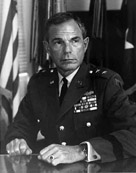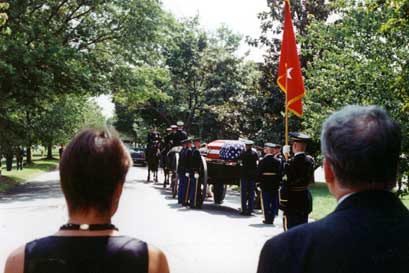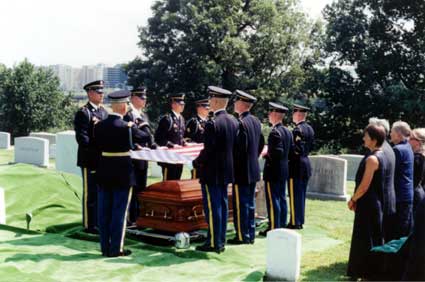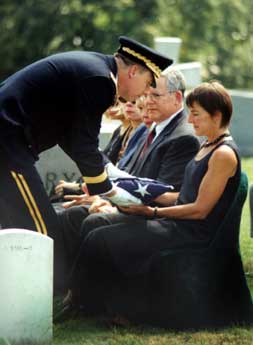From a contemporary press report
Roland M,. Gleszer, 85, of St. Petersburg, Florida,died Friday (August 25, 2000) at Bayfront Medical Center.
Born in Brewer, Maine, he came here in 1973 from Washington, D.C., where he retired as an Army Major General after 33 years. He was an infantry commander in World War II, Korea and Vietnam. His major commands included the 5th Infantry Division Mechanized, Fort Carson, Colorado, and the Military District of Washington, Washington, D.C.
He served on the Army General Staff and was chief of the Army mission to Saudi Arabia and deputy chief of staff of the task force that tested the first hydrogen bomb at Eniwetok Atoll, Marshall Islands.
He was awarded two Distinguished Service Medals, the Legion of Merit, two Bronze Star Medals, the French Croix de Guerre with Palm, the Polish Medal of Valor and the Combat Infantryman’s Badge. He received an honorary doctor of law degree from the University of Maine.
A 1940 graduate of West Point Military Academy and a past president of the West Point Society of Florida’s West Coast, he had served as director of the Florida region on admissions to the academy. He was a former member of the board of Suncoast Tiger Bay Club and the SPCA of St. Petersburg. He was a past vice president of Pinellas County Sheriff’s Junior Deputies League and a past commander of the Military Order of World Wars. He belonged to St. Andrew’s Masonic Lodge 83, Bangor, Maine. He wrote “My View” columns in the St. Petersburg Evening Independent and guest columns for the St. Petersburg Times.
Survivors include a son, Peter E., Westlake Village, Calif.; a daughter, Susan M. Beaudry, Seattle; and two granddaughters.
Helen Slee Gleszer, 78, of St. Petersburg, died April 15 1999.
Courtesy of the Military District of Washington
ARLINGTON NATIONAL CEMETERY, September 1, 2000 — Retired Major General Roland M. Gleszer, commander of the Military District of Washington during a tumultuous period, was laid to rest today at a funeral service attended by his son and daughter. The cremated remains of his wife, Helen, were interred with him.
Yesterday would have the 60th wedding anniversary for the couple, Chaplain (Lieutenant Colonel.) James May noted at the graveside service. They lived together in retirement, summering in Corea, Maine, and wintering in St. Petersburg, Florida, where they came to live year-around. But Helen passed away April 15, 1999, at age 78, while her husband died Friday at their home after an extended illness and hospitalization. He was 85.
Gleszer assumed command of the Military District of Washington September 1, 1969, when it was a subordinate command of the U.S. Army Continental Army Command. When he departed, 31 months later, the command had been streamlined, its headquarters moved, and its reporting headquarters changed from Fort Monroe, Virginia, headquarters of CONARC (now Forces Command), to Army headquarters.
Retired Lieutenant Colonel Mark Murray, who came to MDW from Fort Carson, Colorado, to establish the position of secretary to the general staff, recalled the time Gleszer was in command as exciting times not only because of changes he brought to the command. “MDW was responding to riots in the city of Washington almost on a monthly basis,” Murray said. “As MDW commander, General Gleszer was commander of troops,” including units brought in to augment those of MDW and prevent antiwar protests from paralyzing the city.
Assignments before and after MDW also linked Gleszer to challenges posed by the unrest of the day. An aide de camp during Gleszer’s command of the 5th Infantry Division (Mechanized) at Fort Carson, Colorado, and at MDW, Reid F. Holbrook said that soldiers from Fort Carson backstopped civil authorities during unrest in 1968, a year that saw Martin Luther King Jr. and Robert F. Kennedy murdered and violent demonstrations at conventions of the major parties. Holbrook, who now practices law in Kansas City, Kansas, opined that the working relationship Gleszer had built with the Justice Department’s senior leaders was a factor in his becoming Director of Military Support under the Chief of Staff of the Army after leaving MDW.
Gleszer was born March 18, 1915, in Brewer, Maine, and attended three years of college majoring in journalism at the University of Maine at Orono before accepting an appointment to the U.S. Military Academy at West Point in 1936.
He was the only son of Judge Edward I. Gleszer, and his mother was also trained in the law.
As a general he sought aides with law degrees, according to Holbrook, now senior partner of Holbrook, Heaven & Osborn, Kansas City, Kansas. And he was himself presented an honorary doctor of laws by the University of Maine in 1967.
Graduating with the Class of 1940, the new second lieutenant of infantry went through Basic Infantry Officers’ Course at the Infantry School, Fort Benning, Georgia. While he was a student at Fort Benning, Gleszer and the former Helen West Slee slipped over the state line and married in Alabama.
In December 1940 he was assigned to the 32nd Infantry Regiment of the 7th Infantry Division at Fort Ord, California, a commander of Company L and later of the Anti-Tank Company. Gleszer bracketed America’s entry into World War II with promotions to first lieutenant and then captain.
Gleszer’s wartime service continued a Camp Wolters, Texas, which had the mission of training infantrymen and officers for the war. Within 10 months, however, he was tapped for Command and General Staff College at Fort Leavenworth, Kansas. He graduated in April 1943 — a major assigned to become Regimental S-3 of the 290th Infantry Regiment, of the newly activated 75th Infantry Division, which would train in Missouri, Louisiana and Kentucky before shipping overseas. Seven months into the train-up Gleszer assumed command of the 290th’s 3rd Battalion, which he would lead in combat.
Before shipping out, Gleszer and his wife welcomed their first child, a son, Peter Eaton, into the world. Their second child, Susan Merrill, waited until after the war to be born.
A newly promoted Lieutenant Colonel Gleszer and the rest of the division embarked for England in October, and on December 13 landed in France, where three days later the front in the mountainous Ardennes Forest erupted with a desperate German counter-offensive. The new division was committed to the breach in the First Army sector, arriving Christmas Eve and Christmas Day. Gleszer led his battalion through that month-long struggle and then on to the Colmar Pocket and across the Rhine to the Ruhr Pocket.
When the fighting was over, in April 1945, Gleszer was assigned to the General Staff of Headquarters, U.S. Forces, Europe, not returning to the United States for reassignment until June 1947, more than two years past the May 8 VE Day.
Gleszer’s next assignments followed: assistant chief of staff, G-2, (Intelligence), Headquarters DA from June 1947 to April 1950 and then assistant chief of staff Joint Task Force 3 Headquarters on Eniwetok Atoll, the Marshall Islands, for atomic bomb testing. He served in a similar capacity on the staff of Joint Task Force 132, which detonated the first hydrogen bomb.
After graduation from the Armed Forces Staff College at Norfolk, Va., in July 1953, Gleszer was assigned to the Military Assistance Advisory Group – Saudi Arabia, first as chief of the Army Section and then chief of staff and deputy chief of the MAAG.
At the rank of colonel from Jan. 31, 1955, his subsequent assignments in the 1950s and early 1960s included:
A stint at the Infantry School at Fort Benning as chief first of the Basic Tactics Group and later the Associate Arms Group. Student at the Army War College, Carlisle, Pennsylvania. Schofield Barracks, Hawaii, first as commander 2d Battle Group, 21st Infantry Regiment, 25th Infantry Division, and later deputy brigade commander, brigade commander and finally chief of staff of the 25th Infantry Division. (Gleszer’s son was to win a Silver Star commanding a company of the 25th Infantry Division in Vietnam.) In June 1961, Gleszer assumed command of the 2d Regiment, U.S. Corps of Cadets, at West Point. Two years later he served a third year, as the director of Military Instruction.
Deputy director of programs in the office of the Deputy Chief of Staff for Personnel, Headquarters, Department of the Army. Geszer took promotion to brigadier general on joining the 2nd Infantry Division in Korea as the assistant division commander – maneuver, in July 1965. Thirteen months later he had rotated back to Washington, becoming director of management in the Office of the Comptroller of the Army. Among honors coming his way with that assignment were nomination to the temporary grade of major general and permanent grade of brigadier general, award of the Distinguished Service Medal, and receipt of an honorary Doctor of Laws degree from the University of Maine – Orono, which he had attended before West Point.
At the commencement, Gleszer delivered an address titled “To strive, to seek, to find, and not to yield.” In it he told the graduates that the worldwide challenge of communism demanded that the country strive “for a more disciplined and more industrious citizen,” a statement that Murray characterizes as “pure Gleszer.”
Both Murray and Holbrook testify to the profound impact the general had on their lives. “He was a person who got things done,” Murray said. “Old school Army, a little profane. Looked for results.”
“He had a number of adages he often used,” Holbrook said, “such as ‘Set reasonable goals. Work like hell to accomplish them.'” He did not mince words with those close to him when he was displeased, but had a way of letting others in his command know when their performance was below par. “He carried a set of business cards that read “Otis T. Lee Award” which he would occasionally bestow. “Pretty soon people caught on that ‘Otis T. Lee’ stood for ‘out to lunch’,” Holbrook said. Yet he would as readily have Holbrook and other aides draft letters of praise for instances of outstanding performance.
“I never met anyone else quite like him,” Murray said. “You tell General Gleszer stories and people won’t believe you.” Murray recounted the time he as SGS was told by Gleszer that MDW headquarters would be moving into its present quarters on Fort McNair. “I’m going on vacation for two weeks and when I get back this is going to be MDW headquarters,” Murray recalled the gist of Gleszer’s mission. “Tell the post commander to get out.” Marshall Hall, headquarters for the National Defense University, now stands where the temporary buildings at Fort McNair once stood.
Similarly the decision in 1971 to elevate MDW to major command status came about following a phone call to then Chief of Staff General Bruce Palmer that Gleszer planned to begin handling a budget reduction passed along by Continental Army Command by closing the command’s commissary the next week. Palmer called back the same day to tell Gleszer MDW would become a major command reporting directly to DA and that the deep cut would not be taken, Murray said. Improvements in post exchange and commissary facilities turned out to be one of the hallmarks of Gleszer’s MDW legacy.
In retirement, Gleszer became active in a number of civic activities in the Tampa Bay area, where he also became an avid boater. He was a member of the board of directors of the Suncoast Tiger Bay Club, a member of the Tampa Bay Area Committee on Foreign Relations, a member of the coordinting committee of the Florida West Coast Miliatary Assistance to Traffic and Safety, a member of the University of Maine Development Council, a member of the board of directors of the Society for the Prevention of Cruelty to Animals of St. Petersburg, a Mason, vice president of Pinellas County Sheriff’s Junior Deputies League, former director of admissions for the Florida U.S. Military Academy, past president of West Point Society of Florida West Coast, and past commander of the Military Order of World Wars.
When Gleszer’s health began to fail him around 10 years ago, his son explained, his parents began spending all of their time in Florida. Gleszer was afflicted with chronic arthritis and experiences post polio syndrome, weakening of muscles in old age from a bout with polio as a child. He was in and out of the hospital and experienced a number of minor strokes. His last hospitalization lasted a week.
Gleszer holds the Combat Infantryman’s Badge, the Distinguished Service Medal with Oak Leaf Cluster, the Legion of Merit, the Bronze Star Medal with Oak Leaf Cluster and the Army Commendation Medal with Oak Leaf Cluster. His foreign decorations include the French Croix de Guerre with Palm, the Polish Medal of Valor, the Czechoslovakia Medal of Merit 1st Class and the French Medal of Reconnaissance 1st Class.
His son, Peter, now an executive with Boeing, also had a military career as a West Point graduate and a Vietnam War veteran. He lives with his wife, Barbara, in Westlake Village, Calif. His daughter, Susan, married 1st Lt. Stephen J. Beaudry while the Gleszers were stationed at Fort Carson. The couple now lives in Seattle where Susan works in massage therapy. Third-generation Gleszers comprise the Beaudry’s two granddaughters, Kea Rench and Dana Beadry.
At the time of death he was working with Millie Joplin, also of St. Petersburg, on an autobiography. “It is heavily focused on his work,” his son said. “His life was his career.”
GLESZER, HELEN
- DATE OF BIRTH: 01/19/1921
- DATE OF DEATH: 04/15/1999
- BURIED AT: SECTION 4 SITE 3316-A
ARLINGTON NATIONAL CEMETERY - WIFE OF GLESZER, ROLAND M MG US ARMY
GLESZER, ROLAND M
- MG US ARMY
- WORLD WAR II, KOREA, VIETNAM
- DATE OF BIRTH: 03/18/1915
- DATE OF DEATH: 08/25/2000
- BURIED AT: SECTION 4 SITE 3316-A
ARLINGTON NATIONAL CEMETERY
Susan M. Beaudry and Peter E. Gleszer watch as the casket bearing remains of their mother and father is placed on a caisson at Arlington National Cemetery for the walk to the burial site. Former MDW commander Retired Maj. Gen. Roland M. Gleszer, 85, died Aug. 25. Their mother, Helen, died in 1999, and her cremated remains were buried September 1 with her husband of nearly 60 years.
Chaplain (Lieutenant Colonel) James May officiates at internment services September 1, 2000, at Arlington National Cemetery for former MDW commander, Major General Roland M. Gleszer, and his wife, Helen. Gleszer commanded MDW during the years 1979 to 1972.
Major General James T. Jackson, commander of the U.S. Army Military District of Washington, presents Susan M. Beaudry with the flag that covered the casket bearing remains of her father, Major General Roland M. Gleszer, at his funeral Friday (September 1, 2000) at Arlington National Cemetery. Peter E. Gleszer, Beaudry’s brother, sits to her right.
Michael Robert Patterson was born in Arlington and is the son of a former officer of the US Army. So it was no wonder that sooner or later his interests drew him to American history and especially to American military history. Many of his articles can be found on renowned portals like the New York Times, Washingtonpost or Wikipedia.
Reviewed by: Michael Howard





